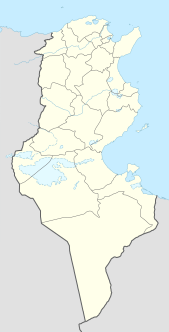Felix (d. 303) was a bishop of Thibiuca in Africa who was martyred during the Great Persecution under the Roman emperor Diocletian alongside Audactus, Fortunatus, Januarius, and Septimus. Felix is said to have resisted the command of the local magistrate Magnillian to surrender his church's copies of the Christian scriptures. In one account, Felix and the others were taken to Carthage and decapitated on July 15. These Five Martyrs of Carthage were venerated in the basilica of St Faustus. Another placed his martyrdom at Venosa in Italy. His companions may have been deacons but, apart from their joint martyrdom with Felix, are now unknown. Their feast day was observed jointly on October 24.
Nigizubi was a Roman–Berber town in the province of Numidia. It was located in modern Algeria. It was also the seat of an ancient bishopric.during the Vandal Kingdom and Roman Empire. The exact location of the ancient town is now lost but it was somewhere in north-eastern Algeria.

Siccenna was a Roman Era town and episcopal see in the Roman province of Africa Proconsularis in what is today northern Tunisia, which is now a Latin Catholic titular bishopric.
Buleliana was a civitas (town) and bishopric in Roman North Africa and remains a Latin Catholic titular see.

Buslacena was a Roman town and the seat of an ancient Christian bishopric in the Roman province of Africa Proconsularis.
Cellae in Proconsulari was an ancient city and bishopric in Roman Africa, which remains a Latin titular see.

The Diocese of Sicca Veneria is a titular see of Africa Proconsularis, and was a suffragan of the bishops of Carthage. The cathedra of the bishopric was in the Roman colonia of Colonia Julia Veneria Cirta Nova Iulia. The bishopric was founded in early Christianity, becoming at some point an archbishopric and passed through the Catholic Roman, Arian Vandal, and Orthodox Byzantine empires until it ceased to function sometime after the Muslim conquest of the Maghreb. It survives today as a titular see of the Roman Catholic Church. The current bishop is Lajos Varga of Hungary.
Paria in Proconsulari is an Ancient town and former bishopric in Roman Africa and now a Latin titular see of the Roman Catholic Church.

Henchir-Khachoum is a locality and series of archaeological sites in Sidi Bouzid Governorate modern Tunisia. The ruins are strewn along a tributary of the Oued El Hatech river east of Sbeitla. During the Roman Empire there was a Roman town of the Roman province of Africa Proconsularis, called Muzuca, one of two North African towns to bare that name.

Mattiana was a Roman-Berber civitas in the province of Africa Proconsularis. The locale existed during late antiquity, and was situated in northern Tunisia.

Uzzipari was a Roman town of the Roman Empire during late antiquity. An exact location for the town has been lost to history although that it was in the Roman province of Africa Proconsolaris means it must have been in northern Tunisia.

Zarna was a Roman town of the Roman Empire during late antiquity. An exact location for the town has been lost to history, although that it was in the Roman province of Africa Proconsolare means it must have been in northern Tunisia.

Culusi was a Roman town of the Roman province of Africa Proconsolare, located near Carthage. It is also known as Culcitana or Culsitana. The city is tentatively identified with ruins in the suburbs of Tunisia.

Ksour-El-Khaoua is a locality in southern Tunisia, North Africa. During the Roman Empire the town was a civitas (town) in the Roman province of Byzacena. and the seat of an ancient Christian bishopric.

The Diocese of Cusira is a home suppressed and titular see of the Roman Catholic Church.

The Diocese of Dices, is a titular see of the Roman Catholic Church. The location of the seat of the diocese is unknown for certain, but is perhaps identifiable with Henchir-Sidi-Salah, Tunisia. Henchir Sidi Salah was an ancient diocese in the Roman-Berber province of Byzacena.
Cabarsussi, was an ancient civitas (municipality) and bishopric in the Roman province of Byzacena, that is tentatively identifiable with ruins at Drâa-Bellouan in modern Tunisia. The current bishop is Terence Robert Curtin, auxiliary bishop of Melbourne.

Precausa was an ancient civitas of the Roman province of Byzacena in North Africa. Its exact location remains unknown but it was in the present Sahel region of Tunisia.

Selendeta was an ancient civitas of the Roman Province of Byzacena during the Roman Empire and late antiquity. The exact location of the town is unknown but it was somewhere in southern Tunisia.
The diocese of Vannida Latin: Dioecesis Vannidensis) is a suppressed and titular see of the Roman Catholic Church. It was centered on the ancient Roman town of Vannida, in what is today Algeria, is an ancient episcopal seat of the Roman province of Mauretania Caesariensis.





